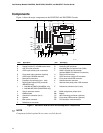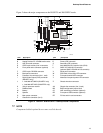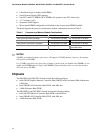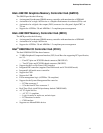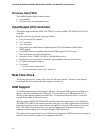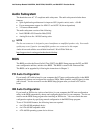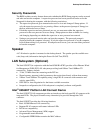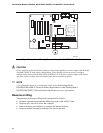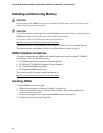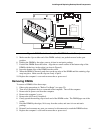
Intel Desktop Boards D815EEA2, D815EPEA2, D815EFV, and D815EPFV Product Guide
20
Audio Subsystem
The boards have an AC ’97 compliant audio subsystem. The audio subsystem includes these
features:
• Split digital/analog architecture for improved S/N (signal-to-noise) ratio: > 90 dB
• Power management support for APM 1.2 and ACPI 2.0 (driver dependent)
• 3-D stereo enhancement
The audio subsystem consists of the following:
• Intel 82801BA I/O Controller Hub (ICH2)
• Analog Devices Inc. AD1885 analog codec
✏
NOTE
The line out connector is designed to power headphones or amplified speakers only. Poor audio
quality may occur if passive (non-amplified) speakers are connected to this output.
Audio drivers and utilities are available from Intel’s World Wide Web site:
http://support.intel.com/support/motherboards/desktop
BIOS
The BIOS provides the Power-On Self-Test (POST), the BIOS Setup program, the PCI and IDE
auto-configuration utilities, and the video BIOS. The BIOS is stored in the Firmware Hub.
The BIOS can be upgraded by following the instructions in Chapter 3.
PCI Auto Configuration
If you install a PCI add-in board in your computer, the PCI auto-configuration utility in the BIOS
automatically detects and configures the resources (IRQs, DMA channels, and I/O space) for that
add-in board. You do not need to run the BIOS Setup program after you install a PCI add-in
board.
IDE Auto Configuration
If you install an IDE device (such as a hard drive) in your computer, the IDE auto-configuration
utility in the BIOS automatically detects and configures the device for your computer. You do not
need to run the BIOS Setup program after installing an IDE device. You can override the auto-
configuration options by specifying manual configuration in the BIOS Setup program.
To use ATA-66/100 features, the following items are required:
• An ATA-66/100 peripheral device
• An ATA-66/100 compatible cable
• ATA-66/100 operating system device drivers



